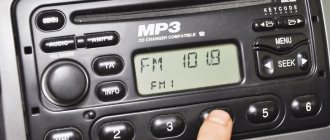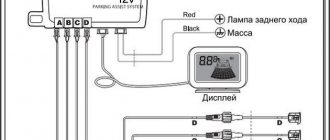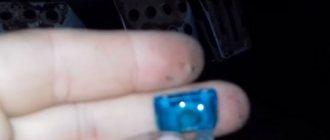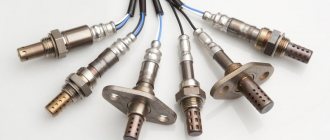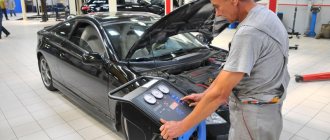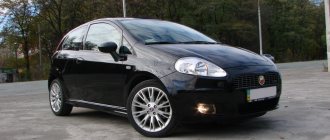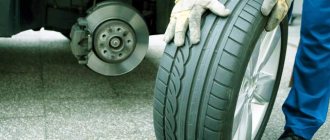Rust on a car is a headache for all drivers without exception. It is almost impossible to prevent its occurrence.
If you find corrosion on your car, there is no need to be upset, as you can deal with it on your own.
The article will discuss how to quickly and easily remove rust from a car with your own hands, without contacting a service center, what needs to be done and what is not recommended.
How to get rid of corrosion on car metal?
There are several ways to remove rust. Folk remedies and special formulations come to the rescue. You can also try to get rid of corrosion using a mechanical or electrochemical method.
How to remove rust using improvised means?
To remove shallow corrosion, it is not necessary to go to the store . There are means to remove it in almost every home or garage. And they are very cheap.
Vinegar
Metal oxides can be removed using table vinegar 9%.
If the damage is deep, then use essence mixed with water in equal parts.
The method of application is simple. It is enough to apply acid to the damaged area, or immerse the part in it (if it is removable).
The optimal exposure time is 2 hours. After processing is completed, the metal is washed with clean water. Read about using vinegar to combat rust here.
How to scrub with soda?
Soda is used to remove rust as follows:
- prepare a thick soda paste;
- apply it to the damaged area of the car;
- leave for half an hour;
- Clean off corrosion with a brush with medium-hard bristles.
If the problem cannot be solved the first time, the procedure is repeated.
How to remove with carbonated water
Soda contains phosphoric acid, which is found in most specialized rust removers.
Even a small amount is enough to remove corrosion from the car. Coca-Cola, Fanta, Pepsi and Sprite are suitable for removing oxides.
Mode of application:
- Soak the damaged part in sparkling water overnight.
- If it is not possible to remove it, soak a cloth with the product and apply it to the oxidized area. The top is covered with polyethylene to prevent the carbonation from evaporating.
- After 12 hours, the composition is washed off with clean water.
This method has 3 advantages: it is safe for metal, highly effective and does not require financial investment. You can learn about the use of Coca-Cola in the fight against rust here.
How to remove with citric acid?
Citric acid acts in a similar way to vinegar . It is used not in pure form, but in diluted form.
10-20 g of preservative is sufficient per liter of water. The product is dipped into the prepared solution, or the damaged area is generously moistened with it. You can apply a cloth soaked in lemon juice as a compress.
The optimal holding time is 2-4 hours. If the rust layer is significant, it is increased by 2 times. The concentration of the main active ingredient is increased by the same amount. Read more about the cleaning method here.
Potatoes and laundry soap
You can get rid of pitting corrosion on your car using potatoes and soap. Mode of application:
- the vegetable is cut into 2 parts;
- the cut is rubbed with laundry soap;
- clean the damaged areas with half a potato; you can leave the vegetable on the surface of the part for an hour;
- After cleaning is completed, the treated part is washed with water.
Using potatoes you can get rid of shallow corrosion. This method is not suitable for processing large areas.
How to clean rust marks with special compounds?
You can remove rust from a car using special products. These include:
WD-40 .
The product is sold in all car enthusiast stores. These anti-corrosion products are used not only for cleaning, but also to prevent the formation of rust on any metal surfaces. The composition penetrates even into the smallest pores, thereby increasing the degree of cleaning. Among car enthusiasts, WD-40 is better known as “liquid key”. The universal remedy costs about 300 rubles.- converters . They contain zinc and manganese salts. Their use allows you to quickly and safely get rid of corrosion, as well as prevent its reappearance. After applying the converter to the metal, a film is formed on it that can last from 3 to 12 months. The average price for converters is 250 rubles.
- removers designed for cleaning cars. Most often they contain acids that can cope even with old stains. Such compositions can be used before upcoming painting. The average price per package is 300 rubles.
- Car plasticine with rust converter. This substance is similar in consistency to ordinary children's plasticine, but has different properties. It is used not only to remove rust, but also to prevent its occurrence. The product is inexpensive, costs about 100 rubles.
- Household chemicals for rust removal. Universal formulations can be purchased at almost every retail store. However, you need to use them to clean your car carefully, after reading the instructions. To begin with, the composition must be tested on an inconspicuous area, since such products are not suitable for all surfaces. The average price is 150 rubles per package.
The choice of specialized products is varied, so you can choose the optimal composition for each specific case.
Removal by electrochemical method
The electrochemical rust removal method is suitable for self-implementation. With its help, you can solve two problems at once: get rid of corrosion and prevent its reappearance.
This method is suitable for cleaning removable and cast parts. In the first case, it is unscrewed from the car and completely immersed in the solution. In the second case, the corroded areas are treated using batteries, “burning” the damaged surface with them.
To implement this method you will need:
- energy source, such as a battery,
- water,
- piece of stainless steel and wire.
The part that needs cleaning is connected to the “minus” of the battery, and the stainless steel to the “plus”. The start of the reaction will be indicated by active bubbling of water (electrolyte). Read about how to remove rust using a battery here, and about the electrolysis method here.
How to clean mechanically?
Mechanical cleaning involves removing rust using any devices or abrasives. Implementation method:
Remove loose metal with sandpaper.
Cleaning is carried out both manually and using a power tool, for example, a grinder. In this case, it is necessary to control the force of pressing on the tool, which will prevent the appearance of deep scratches.- Cleaning should continue until all corrosion has been removed.
- After removing the oxides, the car is treated with a rust converter. This is done in order to remove rust from the depths of the metal, from small cracks that are not visible to the naked eye.
- Degrease the surface, putty and paint it.
The better the mechanical cleaning, the more durable the result. This article will tell you about anti-rust paints for cars.
see also
How to wash your car in winter
- 4 0 3k
Anti-gravel treatment
- 41 0 36k
Anti-gravel for car body
- 28 2 29k
The best wax for a car
- 40 0 41k
Which sound insulation for a car should you choose?
- 47 0 47k
The fight against car corrosion often causes a lot of problems for its owner. For this, three main methods are used - passive, active and electrochemical, but each of them has its own advantages and disadvantages. Most often, corrosion is removed using special means. And for preventive purposes, a protective film is glued to the bottom, body thresholds and other hidden places or treated with mastic. There are also other preventive measures, which we will talk to you about later.
How to treat different areas of the car with your own hands?
Depending on the part of the car on which rust has appeared, the method of cleaning it will differ. Features to pay attention to:
- From the body . It is impossible to remove the body and soak it in a cleaning solution. The treatment should be as gentle as possible so as not to damage areas not damaged by corrosion. You can use both folk remedies and specialized formulations. The mechanical method is used with caution.
- From the arches . Arches are most often cleaned mechanically. After removing the rust, they are treated with an anti-corrosion compound and coated with paint.
- From the engine number . If the number is not readable under a thick layer of rust, you can remove it with improvised means. It is best to use Coca-Cola or table vinegar. The use of caustic compounds and mechanical cleaning are avoided.
- From brake discs and calipers . These parts are removable, so the electrochemical method with full immersion is often used to remove corrosion.
- From the gas tank . The gas tank is treated with compounds containing acids. They are poured inside, shaken thoroughly and left to act for several hours.
This article will tell you how to flush the cooling system from rust and scale.
Useful tips
In order for do-it-yourself anticorrosive treatment to be successful, you need to follow several important rules:
- preparation for processing is as important a part as applying anticorrosive;
- the protective mixture should include only professional products and the above ingredients; it is undesirable to use components based on the slander of friends;
- processing conditions must coincide with the regime that is usually installed in car services.
Treatment of internal cavities
How to treat a car with anticorrosive agent? For these purposes, you will need an anti-corrosion agent and a spray bottle with a flexible nozzle. The nozzle of the sprayer should be inserted deep into the cavity until it stops. When pulling the device back, you need to continuously spray the protective composition.
The thinner the anticorrosive agent, the more often it should be sprayed. If drops of anticorrosive begin to seep out of the hole, it means the work was completed successfully. If this phenomenon does not occur, you need to clean the cavity with a metal nozzle, and then repeat the procedure again.
- in the absence of technological holes, it is necessary to make them yourself, but very competently and in a minimum quantity;
- if there are a large number of mechanical devices and electric drives in the car, it is advisable to remove the trim completely;
- if the treatment is carried out in the internal cavities of the door, you need to spray the material without removing the upholstery;
How to properly carry out prevention?
It is much easier to prevent rust from occurring than to fight it. To this end, it is recommended to take the following measures:
Do not leave your car dirty, wash it regularly.- Install mudguards.
- Treat the car with polishing compounds. You can do this yourself, or in specialized services.
- Carry out anti-corrosion treatment of the underbody of the car at least once every 6 months.
You need to clean off rust as soon as its first signs appear. This will prevent the spread of corrosion over large areas.
You can learn about ways to protect your car from rust from this article.
Prevention and methods of protecting cars from corrosion
Protecting your car from corrosion is a simple matter. But it must be carried out without fail. You can reduce the risk of corrosion by following a number of simple rules:
- Car care in winter - you need to wash your car every few days. The water should be warm, but under no circumstances hot. Proper drying after washing is mandatory.
- Regularly inspect the body for damage and pockets of rust - in the initial stages it is much easier to get rid of them.
- Applying anti-corrosion coating to the bottom, arches and other open elements of the car before the winter season. The treatment will seal the metal and prevent rust from spreading.
- Periodic waxing of paintwork. This protection of the car body from corrosion is not very durable, but is very effective. Wax stops micropores, and polishing creates an additional protective coating.
Preparing a car for winter is a complex task, in which there are many nuances and tricks. Therefore, it is better to entrust it to professionals. In the Autobooking online catalog you will find hundreds of reliable auto repair shops where they can help you clean your car from corrosion. Visit the website and look for the nearest service station at a time convenient for you.
You can apply anti-corrosion coating to your car. To do this, use the form below to search for a service station:
Wrestling Tips
To get rid of rust on your car and not damage it, you need to listen to the advice of experts:
- If the part is soaked in any solution, then tin basins cannot be used as containers. Glass or plastic containers are suitable for work.
- You can leave the product on the metal surface no longer than the time specified in the instructions.
- After completing cleaning, the treated area should be rinsed with water, unless otherwise specified in the instructions for use. This is done to ensure that the chemicals do not continue to destroy the undamaged metal.
Removing rust from a car body mechanically
Removing rust mechanically involves cleaning areas susceptible to corrosion to bare metal using sandpaper or a wire brush.
After cleaning, such places need to be treated with a rust converter and painted over.
Advantages of mechanical rust removal:
- The ability to remove large areas and complex areas with “swelling” of paint, active “raised” corrosion;
- Everything you need to remove rust can be bought at any automotive or even hardware store;
- Low cost of materials used.
The disadvantage of this method of dealing with rust is that it is quite labor intensive, as well as the duration of the process itself.
To remove rust mechanically we will need:
If the damaged areas are severely corroded, then you need to use coarser sandpaper (grain size 120) or a wire brush. But in most cases, fine sandpaper with 400 or 600 grit will be enough to remove rust.
The operating procedure is as follows:
- Before starting work, wash the car thoroughly so that all damaged areas are clearly visible - instructions on how to properly wash the car.
- Using sandpaper or a brush, the rust must be cleaned down to bare metal. You should not get too carried away with this process, so as not to remove the paint near the damaged area.
- The cleaned surface must be wiped and, if necessary, degreased (depending on the rust converter you use).
- Cover with masking tape the parts of the body adjacent to the damaged area that will not be treated.
- Treat the prepared area with a rust converter to protect the metal from the spread of corrosion in the future. Most of these preparations convert rust into primer, which improves paint adhesion.
- After the rust converter has completely dried, tint the repair areas with cosmetic enamel.
The last sixth point refers to small-area damage. If large areas of the body elements were subject to rust (for example, sills or cavities under bumpers), then cosmetic enamel is not enough - these places will have to be puttied, primed and painted. For more information on how to do this, see our car painting instructions.
Why does corrosion occur?
The destruction of metal occurs from exposure to unfavorable environmental factors.
Corrosion is a broader concept than rust, which most likely can be attributed to its variety. It arises not only from exposure to water, but also to the chemicals that are present in it.
In this regard, the bottom of the car and its body most often suffer from corrosion.
Corrosion can be dry or wet . If car parts are in a dry environment, such as a garage, and still become dull, they need anti-corrosion treatment.
Dry corrosion is not so destructive to the body. But wet corrosion is much worse; the metal becomes covered with a layer of rust and grows regularly.
If the process has just begun, it is necessary to fight it while it is in its infancy, because further it will be much more difficult.
If you park your car in a heated garage simply from the cold air in the winter, in this case the risk of metal destruction increases in case of poor exhaust in the garage.
A sharp temperature change contributes to the appearance of condensation on the metal, and rust begins to have a destructive effect.
Rust most often forms in those who do not clean the bottom during the cold season. This procedure gives only a short-term effect, but the car needs regular care.
After another trip outside your garage, you need to clean the bottom of sand and water again. Constant prevention reduces the risk of corrosion.
Do not delude yourself that only in the cold season the paintwork suffers.
It is worth noting that in warm weather, particles of asphalt and sand fly into it, in this case it is also necessary to take measures, then you will not have to think about which method to choose to remove rust.
How to prevent
Keeping the machine in good working order requires constant maintenance and close supervision. Corrosion not only makes it less attractive, it can cause serious damage if left unchecked.
Rust is an iron oxide; the molecule consists of two iron atoms and three oxygen atoms. It is a product of an electrochemical process called corrosion. To create it, three factors must be present: anode, cathode and electrolyte.
An anode is a piece of metal that will readily give up electrons under certain circumstances. Cathodes are also metals that will accept electrons. Electrolytes are liquids, which facilitate the movement of electrons.
As electrons flow from the anode to the cathode through the electrolyte, this results in anode corrosion. If there is some iron in it, some of the anode metal becomes rust.
The most vulnerable areas are the bottom, trunk, exhaust system, hood, engine, frame and chassis.
The most effective ways to prevent corrosion:
- Wash your car every two weeks, and wax it once a month.
- Purchase a sealant to prevent rust from getting into the damaged part of your car's paint.
- Drivers living in particularly harsh environments may need to purchase a protective lubricant as additional insurance. Lubrication creates an additional layer of protection. Make sure your vehicle is clean and dry before applying any type of protective coating.
- If you drive on icy roads covered with salt, visit the car wash more often.
- Keep your car in the garage. Keeping your car in a garage, or at least keeping it hidden, will protect it from damage caused by adverse weather conditions.
Getting rid of the problem is difficult. It is easier to take measures to prevent its occurrence than to later look for methods on how to remove rust from a car body.
Having a little time, the right tools and knowing how to carry out the procedure correctly, you can easily remove rust from the car body yourself.
Thus, you can save on the workshop and get the desired result with a little effort.
